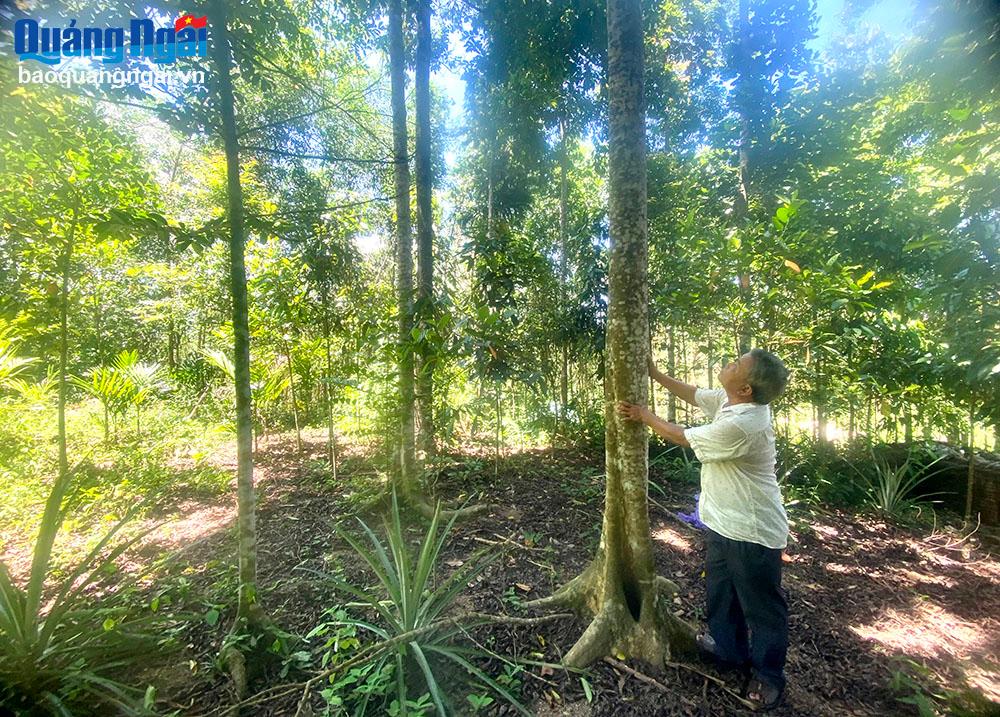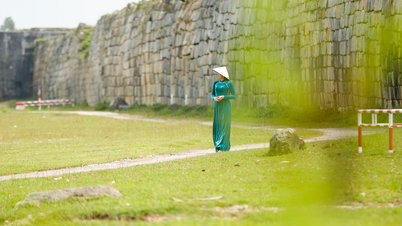(Quang Ngai Newspaper) - Along with forest protection, the forestry sector is striving to implement a program for planting large timber trees and deploying many models and projects for planting native trees. In some localities, instead of planting acacia trees, people have also planted rosewood and green lim trees for higher economic value.
Over the years, Tra Bong district has focused on encouraging people and household groups to develop and convert from acacia plantations to plantations of large, rare timber trees. Recognizing the long-term benefits of planting large timber trees, Mr. Pham Ngoc Thong, in Binh Thanh village, Tra Binh commune (Tra Bong district), has converted a portion of his acacia plantation to planting Dalbergia tonkinensis trees. Mr. Thong shared that Dalbergia tonkinensis trees have straight, tall trunks with sparse foliage, and their wood is strong and suitable for sawing into beams for house construction. A Dalbergia tonkinensis tree over 5 years old can fetch over 4 million VND. In addition, he can plant short-term crops such as pineapple, ginger, and native chili peppers under the forest canopy to generate additional regular income. "Currently, I am expanding the area of large timber plantations and simultaneously developing seedling nurseries for sale," he said.
 |
| Mr. Pham Ngoc Thong's rosewood garden, in Binh Thanh village, Tra Binh commune (Tra Bong district). |
Many households in Tra Bong district have also changed their perception from selling young acacia trees to planting forests that meet FSC (Forest Stewardship Council) standards. A typical example is Mr. Ho Van Kim, in Hamlet 5, Tra Thuy commune (Tra Bong), who currently has 6 hectares of acacia forest planted and protected according to FSC standards. Mr. Kim said that when the government encouraged him to plant forests according to FSC criteria, his family and he had many concerns, the biggest worry being the long planting time and its impact on income. But after receiving guidance and explanations from professional staff, he understood the benefits of planting forests according to FSC standards and decided to participate.
Not only in Tra Bong, but also in the mountainous districts of Ba To, Minh Long, Son Ha, and Son Tay, people are gradually changing their perceptions about reforestation. Along with planting and managing forests according to FSC standards, the agricultural sector and local authorities are encouraging people to increase the planting of native trees such as green lim, sen, sao... to create windbreaks to protect the soil, as well as restore the ecosystem for production forests.
According to Bui Dinh Linh, Head of the Son Ha District Forest Protection Department, the forest cover rate in the district fluctuates at different times due to the harvesting cycle of acacia trees by local people. In particular, harvesting young acacia trees leads to many negative consequences. Therefore, changing people's perceptions about reforestation is crucial. Once more areas are planted with mature timber trees and native species, it will contribute to effectively achieving the target of increasing the forest cover rate in the district.
| The total forested area in the province is nearly 265,000 hectares (almost 107,000 hectares of natural forest and over 158,000 hectares of planted forest). The forest cover rate (including scattered trees) currently stands at 52.33%, an increase of 6.33% compared to 2012. |
According to Pham Duy Hung, Head of the Provincial Forest Protection Department, to effectively protect forests, the forest protection force has strengthened coordination with forest owners and other functional forces in patrolling and strictly handling cases of deforestation and illegal logging. At the same time, they advise the authorities at all levels on the implementation of state management functions regarding forests and forest land; and closely manage wood processing facilities.
To ensure increasingly stable and sustainable forest management and protection, at the beginning of 2024, the Provincial People's Committee issued Decision No. 01/QD-UBND approving the sustainable forest management plan until 2030 of the Provincial Protective Forest Management Board; and Plan No. 125/KH-UBND implementing the Project on Developing the Multipurpose Value of Forest Ecosystems until 2030, with a vision to 2050 in the province.
Text and photos: HONG HOA
RELATED NEWS AND ARTICLES:
Source: https://baoquangngai.vn/kinh-te/nong-nghiep/202408/loi-ich-cua-trong-bao-ve-rung-4320e97/





![[Photo] Prime Minister Pham Minh Chinh presides over a meeting on private sector economic development.](/_next/image?url=https%3A%2F%2Fvphoto.vietnam.vn%2Fthumb%2F1200x675%2Fvietnam%2Fresource%2FIMAGE%2F2025%2F12%2F20%2F1766237501876_thiet-ke-chua-co-ten-40-png.webp&w=3840&q=75)




































































































Comment (0)